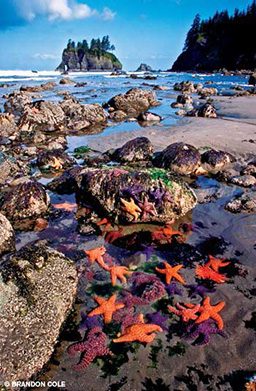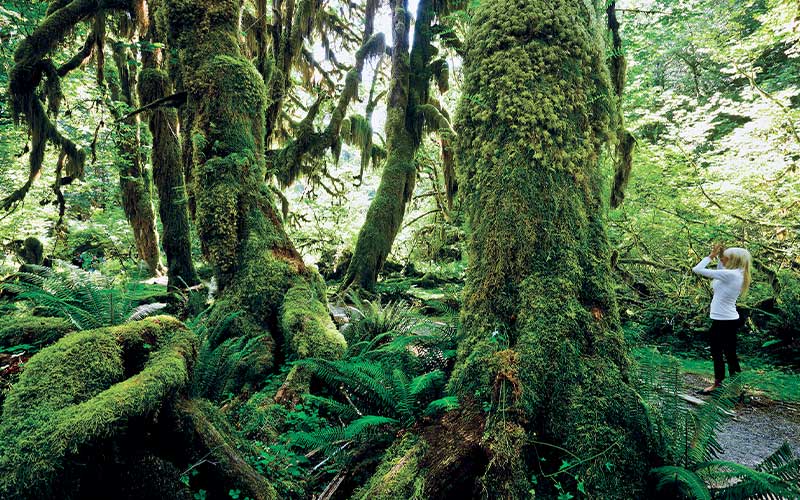I’m standing within a puffin’s glide of Cape Flattery, the northwestern-most point of the lower 48 United States, and I’m poised to plunge off the edge of our continent.
I take a giant stride into Washington’s scuba frontier.

The cool green greets me rather abruptly, but discomfort fades quickly as my mind turns to the business at hand: promptly descending to 60 feet along an invertebrate-smothered wall while fending off playful Steller sea lions. This is Steller Rock, and although one cannot always count on a whiskered welcoming committee here, I’m thrilled to make their goggle-eyed acquaintance. I watch in wonder as they torpedo about.
The site’s topography is impressive: a mix of peaks, valleys and undercuts. White plumose anemones jut upward from the rocky seascape. Mauve sunflower sea stars graze over a dense mat of barnacles and bryozoans, pink hydrocorals, lobed tunicates and orange finger sponges. I focus on the fish, finding camouflaged red Irish lords and yellow-speckled China rockfish. A brutish cabezon, easily a stunt double for Jabba the Hutt, guards a mound of eggs. Fearing I intend infanticide, he’s not budging and allows me to capture a flattering mug shot from up close.
We motor on to Tatoosh Island, passing by the sea lion gang unceremoniously piled atop their rock and basking in the mid-morning fog. Seabirds cry overhead as we pull up into the shadow of a lighthouse. On our second submersion we find nudibranchs, strawberry anemones, crustaceans and multiple rockfish species in a canyon filled with boulders and kelp. It is sublime.
Mushroom Rock is a popular site in the Strait of Juan de Fuca. Exploring it at 50 feet, I spot Puget Sound king crabs in both freakishly large and cute, tiny sizes. Alien in appearance and colorful (think Transformers dressed in tangerine and purple spiked armor), they are prized photo subjects and easy to shoot.
Nearby Slant Rock delivers super-sized rose anemones sprouting from ledges in red and white tentacled clusters. They prove these brisk waters, which average 45°F, are packed with nutrients, pumping up sea creatures to epic proportions. I’m captivated by the lovely kelp bed: The simple elegance of bull kelp fronds waving in the sea breeze, amber blades unfurled and streaming in the current, is poetry in liquid motion.

You’ll never surface from these dives to find a fleet of dive boats crowding around. Odds are you won’t encounter any other divers at all. Out here you’re off the grid. In the shadow of the snowcapped Olympic mountains, nestled under the canopy of an old growth forest, you’re at the end of the road.
Diving headquarters on the Olympic Peninsula is Neah Bay, but calling it a scuba mecca would be quite an overstatement. This rustic fishing town sits at the end of Highway 112 and is home to approximately 1,000 people. It’s the center of the Makah Nation and the gateway to what many experienced Northwest divers consider the finest diving in the state. It can also be some of the most challenging.
Currents tear through the strait and scour the cape. Surge from the heaving Pacific’s titanic swell can flip a diver upside down. The water is cold, and visibility varies dramatically. Fog is commonplace. There’s a potential hazard of entanglement in fishing gear, and, of course, the vast emptiness of open ocean to the west must be respected. By diving smart and within one’s limits, however, those with proper training and preparation will likely log these dives among their best in the Pacific Northwest.

For those lucky enough to actually dive it, Duncan Rock may rank as the peninsula’s best site. The marine life is amazing, with huge fish and thick blankets of rainbow invertebrates. But this legendary spot, alone in the strait’s opening, should be attempted only by those with sharp, advanced skills. It’s an extreme dive due to current, surge, depth, exposure and fog. Only a handful of days each year yield the right mix of conditions for safe diving.
Duncan is not happening for us this trip. Conditions aren’t perfect, so we pass it by. No worries. In my logbook, I’ve always awarded first-place honors to Waddah Island Fingers. It’s an advanced site just outside Neah Bay and more frequently diveable than Duncan. Charismatic megafauna? Check. Abundant fish and polychromatic inverts? Check. Interesting bottomography? Checkmate. We wait until kelp buoys to the surface, and then we descend into its midst. We punch through a swarm of blue and black rockfish and head to the edge of a narrow ridge. Visibility is 30 feet, enough to truly appreciate the fertile gardens for Metridium anemones, which glow an eerie greenish white. I’m stalking a quillback rockfish that hovers over raspberry soft corals when my buddy points excitedly downslope. A serpentine shape slithers across the gorge. We power ahead attempting to intercept the 6-foot-long wolf eel, but we’re too late. He disappears into his den. Before I can curse, a lumpy head emerges, and with a gap-toothed grin the Muppet monster launches outward into my camera. I love wolf eels.

I’m even more enamored of giant pacific octopuses. At 80 feet we’re given a second major dose of luck when we stumble across a “GPO.” This one is just a teenager, only 5 feet across. It’s on the prowl, probing cracks and crevices. Tasting the substrate with suckered arms, it appears to be hot on the trail of some hapless crab. Then it stands tall, blushes from brown to brick red, and fleshy fingers spring up from its chameleon-like skin. All-knowing eyes scan me up and down. If only I could connect with its alien intellect. If I had gills I’d spend forever down here in its presence, but current is building, and gas is running low. Reluctantly we turn about, and in the calm afforded by the slanting wall, we swim back upslope.
Although most of these sites are accessible only by boat, there are some excellent shore dives on the Peninsula. Sekiu Jetty, 15 miles to the east, hosts hordes of critters crammed into a maze of kelp-covered rocks just beyond the surf line. I see kelp greenlings, ling cod, schools of shimmering baitfish and handsome copper rockfish. The rocks bustle with crustaceans (including very unusual heart crabs), various sculpins and mosshead warbonnets. Piles of discarded shellfish remains mark octopus lairs, and in the adjacent eelgrass I spy stalked jellies and silverspot sculpins. Due to very shallow depths (35 feet maximum) I can submerge for 80 to 90 minutes. Since fishermen often patrol the kelp bed’s outer edge, fly a dive flag if you explore near the perimeter.
Access to my other favorite shore dive, *Salt Creek County Park, can be a bit of a bear. If waves are breaking at Tongue Point, I try Sekiu instead. But at high slack tide with no surf, I’ll scamper (carefully) down the rocks and kick out to explore a remarkable reef between 30 and 60 feet deep.
About 400 yards offshore (and ergo a boat dive) is the wreck of theDiamond Knot. This 326-foot freighter sank in the 1940s and has become an extraordinary artificial reef supporting loads of life. The wreck is deep, resting at 135 feet. Current rips this advanced site, and it’s completely exposed to weather. If conditions are favorable and your training appropriate, dive the Knot with an experienced operator for an exhilarating look into Washington’s maritime history.
“Wild and woolly.” It’s a concise summary of Olympic Peninsula diving and hints at the adventures to be found there. When you’re ready to shake off the smothering cloak of civilization, leave the crowds far behind and immerse yourself in a local diving experience that seems anything but, head west to the edge of the map. You’ll know you’re there when the sea overwhelms you.

How To Dive It

Conditions: Dive season on the Olympic Peninsula is late spring through mid-fall, with most folks targeting late summer. Average water temperatures range from 42°F to 48°F. Visibility may be anywhere from 5 to 50 feet, and plankton blooms can occur. Most of the diving in the Neah Bay region is intermediate to advanced; some sites might even be considered extreme. Weather and sea conditions are prone to sudden changes.
Time your dives for slack water. Some days the current never completely stops, but it usually slows enough to allow diving. It’s safest to go with those who know the local currents. Always evaluate the conditions on site, use a “live” boat, carry surface-signaling devices and have a contingency plan that accounts for current. It’s the lifeblood of Pacific Northwest diving.
Getting there: Neah Bay is a four- to five-hour drive from Seattle and a six-and-a-half-hour drive from Portland, Ore. Take US Highway 101 to Port Angeles on the Olympic Peninsula. Continue west on 101 to the 101/112 junction, and then turn right onto State Highway 112. Drive west on 112 for approximately 11 miles to Salt Creek or 46 miles to Sekiu. Highway 112 ends at Neah Bay, 18 miles west of Sekiu.
© Alert Diver — Q2 Spring 2012